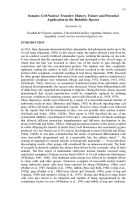Por favor, use este identificador para citar o enlazar este ítem:
https://repositorio.uca.edu.ar/handle/123456789/5493| Campo DC | Valor | Lengua/Idioma |
|---|---|---|
| dc.contributor.author | Sansiñena, Marina Julia | es |
| dc.date.accessioned | 2019-06-06T00:48:31Z | - |
| dc.date.available | 2019-06-06T00:48:31Z | - |
| dc.date.issued | 2011 | - |
| dc.identifier.citation | Sansinena, M. 2011. Somatic cell nuclear transfer : history, future and potential application in the bubaline species [en línea]. Revista Veterinaria. 22(supl. 1). Disponible en: https://repositorio.uca.edu.ar/handle/123456789/5493 | es |
| dc.identifier.issn | 1669-6840 (online) | - |
| dc.identifier.issn | 1668–4834 | - |
| dc.identifier.uri | https://repositorio.uca.edu.ar/handle/123456789/5493 | - |
| dc.description.abstract | Introduction: In 1914, Hans Spemann demonstrated that salamanders had pluripotent nuclei up to the 16-cell stage (Spemann, 1938). In this classic study, the author utilized a hair from his son to constrict a newly fertilized salamander zygote, isolating the nucleus on one side. It was observed that the nucleated side cleaved and developed to the 16-cell stage, at which time the hair was loosened to allow one of the nuclei to pass through the constriction and into the non-nucleated portion. The ligature was then completely tightened, cutting the embryo in half. Cell division occurred in the newly nucleated portion of the cytoplasm, eventually resulting in twin larvae (Spemann, 1938). Research by other groups demonstrated that nuclei from early amphibian embryos transferred to appropriate cytoplasm were totipotent (Briggs and King, 1952; Gurdon, 1961, 1962; McKinnell, 1962). However, as researchers transferred nuclei from individuals more advanced developmentally, the success rates decreased. Nuclei from differentiated cells of adult frogs only supported development to tadpoles. During this time, classic research demonstrated that sexual reproduction could be completely replaced by defining necessary conditions for culturing somatic carrot cells (Steward et al., 1958, 1970). These impressive results were followed by a report of a successful nuclear transfer of embryonic nuclei in mice (Illmensee and Hoppe, 1981) by directly injecting inner cell mass (ICM) cell nuclei into enucleated zygotes. However, these results were followed by the reports that full development in mice was not possible after nuclear transfer (McGrath and Solter, 1983a, 1983b). Their report in 1983 described the use of the cytoskeletal inhibitor cytochalasin B (CB) and a virus-mediated cell fusion technique that allowed efficient pronuclear transplantation and full-term development in the mouse (McGrath and Solter, 1983a). Although pronuclear transfer in the mouse resulted in viable offspring the transfer of nuclei from 2-cell blastomeres into enucleated zygotes produced very few blastocysts (13%) and no development to term (McGrath and Solter, 1983a, 1983b). It was then concluded that the nuclei of advanced differentiated cells were irreversibly programmed and, in a memorable line, the authors stated: “…the cloning of mammals by nuclear transfer is biologically impossible…”. Even with these discouraging results, other groups still considered this an unanswered point. The body of research in domestic animals has always been driven by the economic value of farm animals | es |
| dc.format | application/pdf | es |
| dc.language.iso | eng | es |
| dc.publisher | Universidad Nacional del Nordeste | es |
| dc.rights | Acceso Abierto | es |
| dc.rights.uri | https://creativecommons.org/licenses/by-nc-sa/4.0/ | es |
| dc.source | Revista Veterinaria, 22:supl. 1, 2011 | es |
| dc.subject | CELULAS SOMATICAS | es |
| dc.subject | TRANSFERENCIA NUCLEAR DE CELULAS | es |
| dc.subject | RAZA BUBALINA | es |
| dc.title | Somatic cell nuclear transfer : history, future and potential application in the bubaline species | es |
| dc.type | Artículo | es |
| uca.path | Facultad de Ingeniería y Ciencias Agrarias|Artículos | es |
| uca.disciplina | PRODUCCION AGROPECUARIA | es |
| uca.filename | /home/data-uca-generic/folder_generic_common/Ing. y Cs.Agrarias/Art�culos/somatic-cell-nuclear-transfer/metadata.xml | es |
| uca.issnrd | 1 | es |
| uca.affiliation | Fil: Sansiñena, Marina Julia. Pontificia Universidad Católica Argentina. Facultad de Ingeniería y Ciencias Agrarias; Argentina | es |
| uca.version | publishedVersion | es |
| item.languageiso639-1 | en | - |
| item.grantfulltext | open | - |
| item.fulltext | With Fulltext | - |
| crisitem.author.dept | Facultad de Ingeniería y Ciencias Agrarias | - |
| crisitem.author.parentorg | Pontificia Universidad Católica Argentina | - |
| Aparece en las colecciones: | Artículos | |
Ficheros en este ítem:
| Fichero | Descripción | Tamaño | Formato | |
|---|---|---|---|---|
| somatic-cell-nuclear-transfer.pdf | 627,32 kB | Adobe PDF |  Visualizar/Abrir |
Visualizaciones de página(s)
208
comprobado en 30-abr-2024
Descarga(s)
106
comprobado en 30-abr-2024
Google ScholarTM
Ver en Google Scholar
Este ítem está sujeto a una Licencia Creative Commons

